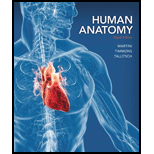
Human Anatomy (8th Edition) - Standalone book
8th Edition
ISBN: 9780321883322
Author: Frederic H. Martini, Robert B. Tallitsch
Publisher: PEARSON
expand_more
expand_more
format_list_bulleted
Question
Chapter 4, Problem 16RFT
Summary Introduction
Introduction:
Aging is the process of programmed cell death. It means no further growth of cells occurs after a longer period. The most prominent occurrence of aging can be observed in the skin. The presence of wrinkles on the face due to the destruction of the cells are the examples of aging.
Expert Solution & Answer
Want to see the full answer?
Check out a sample textbook solution
Students have asked these similar questions
The Sentinel Cell: Nature’s Answer to Cancer?
Molecular Biology Question
You are working to characterize a novel protein in mice. Analysis shows that high levels of the primary transcript that codes for this protein are found in tissue from the brain, muscle, liver, and pancreas. However, an antibody that recognizes the C-terminal portion of the protein indicates that the protein is present in brain, muscle, and liver, but not in the pancreas. What is the most likely explanation for this result?
Molecular Biology
Explain/discuss how “slow stop” and “quick/fast stop” mutants wereused to identify different protein involved in DNA replication in E. coli.
Chapter 4 Solutions
Human Anatomy (8th Edition) - Standalone book
Ch. 4 - Match each numbered item with the most closely...Ch. 4 - Match each numbered item with the most closely...Ch. 4 - Match each numbered item with the most closely...Ch. 4 - Match each numbered item with the most closely...Ch. 4 - Match each numbered item with the most closely...Ch. 4 - Match each numbered item with the most closely...Ch. 4 - Match each numbered item with the most closely...Ch. 4 - Match each numbered item with the most closely...Ch. 4 - Prob. 9RFTCh. 4 - Label the following structures on the accompanying...
Ch. 4 - The effects of aging on the skin include (a) a...Ch. 4 - Prob. 12RFTCh. 4 - Label the following structures on the accompanying...Ch. 4 - Prob. 14RFTCh. 4 - 15. The layer of the epidermis that contains cells...Ch. 4 - Prob. 16RFTCh. 4 - Prob. 17RFTCh. 4 - Prob. 18RFTCh. 4 - Prob. 19RFTCh. 4 - Explain why fair-skinned individuals have greater...Ch. 4 - Prob. 2RCCh. 4 - Stretch marks are often seen on individuals who...Ch. 4 - Prob. 4RCCh. 4 - 5. List the characteristics that make the...Ch. 4 - Prob. 6RCCh. 4 - 7. Explain what is happening to a person who is...Ch. 4 - Prob. 8RCCh. 4 - 1. You are about to undergo surgery. Explain why...Ch. 4 - Prob. 2CT
Knowledge Booster
Learn more about
Need a deep-dive on the concept behind this application? Look no further. Learn more about this topic, biology and related others by exploring similar questions and additional content below.Similar questions
- Molecular Biology Question A gene that codes for a protein was removed from a eukaryotic cell and inserted into a prokaryotic cell. Although the gene was successfully transcribed and translated, it produced a different protein than it produced in the eukaryotic cell. What is the most likely explanation?arrow_forwardMolecular Biology LIST three characteristics of origins of replicationarrow_forwardMolecular Biology Question Please help. Thank you For E coli DNA polymerase III, give the structure and function of the b-clamp sub-complex. Describe how the structure of this sub-complex is important for it’s function.arrow_forward
- Molecular Biology LIST three characteristics of DNA Polymerasesarrow_forwardMolecular Biology RNA polymerase core enzyme structure contains what subunits? To form holo enzyme, sigma factor is added to core. What is the name of the structure formed? Give the detailed structure of sigma factor and the function of eachdomain. Please help. Thank youarrow_forwardMolecular Biology You have a single bacterial cell whose DNA is labelled with radioactiveC14. After 5 rounds of cell division, how may cells will contain radioactive DNA? Please help. Thank youarrow_forward
- 1. Explain the structure and properties of atoms and chemical bonds (especially how they relate to DNA and proteins). Also add some pictures.arrow_forward1. In the Sentinel Cell DNA integrity is preserved through nanoscopic helicase-coordinated repair, while lipids in the membrane are fortified to resist environmental mutagens. also provide pictures for this question.arrow_forwardExplain the structure and properties of atoms and chemical bonds (especially how they relate to DNA and proteins). Also add some pictures.arrow_forward
- In the Sentinel Cell DNA integrity is preserved through nanoscopic helicase-coordinated repair, while lipids in the membrane are fortified to resist environmental mutagens. also provide pictures for this question.arrow_forward1. Explain how genetic information is stored, copied, transferred, and expressed. Also add some pictures for this question.arrow_forward!. Describe biological macromolecules (DNA, RNA, proteins, lipids, etc.) and how they function in the cell. also provide some images for this question.arrow_forward
arrow_back_ios
SEE MORE QUESTIONS
arrow_forward_ios
Recommended textbooks for you
 Human Biology (MindTap Course List)BiologyISBN:9781305112100Author:Cecie Starr, Beverly McMillanPublisher:Cengage Learning
Human Biology (MindTap Course List)BiologyISBN:9781305112100Author:Cecie Starr, Beverly McMillanPublisher:Cengage Learning
 Human Physiology: From Cells to Systems (MindTap ...BiologyISBN:9781285866932Author:Lauralee SherwoodPublisher:Cengage Learning
Human Physiology: From Cells to Systems (MindTap ...BiologyISBN:9781285866932Author:Lauralee SherwoodPublisher:Cengage Learning Anatomy & PhysiologyBiologyISBN:9781938168130Author:Kelly A. Young, James A. Wise, Peter DeSaix, Dean H. Kruse, Brandon Poe, Eddie Johnson, Jody E. Johnson, Oksana Korol, J. Gordon Betts, Mark WomblePublisher:OpenStax College
Anatomy & PhysiologyBiologyISBN:9781938168130Author:Kelly A. Young, James A. Wise, Peter DeSaix, Dean H. Kruse, Brandon Poe, Eddie Johnson, Jody E. Johnson, Oksana Korol, J. Gordon Betts, Mark WomblePublisher:OpenStax College

Human Biology (MindTap Course List)
Biology
ISBN:9781305112100
Author:Cecie Starr, Beverly McMillan
Publisher:Cengage Learning



Human Physiology: From Cells to Systems (MindTap ...
Biology
ISBN:9781285866932
Author:Lauralee Sherwood
Publisher:Cengage Learning


Anatomy & Physiology
Biology
ISBN:9781938168130
Author:Kelly A. Young, James A. Wise, Peter DeSaix, Dean H. Kruse, Brandon Poe, Eddie Johnson, Jody E. Johnson, Oksana Korol, J. Gordon Betts, Mark Womble
Publisher:OpenStax College
The Integumentary System, Part 1 - Skin Deep: Crash Course Anatomy & Physiology #6; Author: CrashCourse;https://www.youtube.com/watch?v=Orumw-PyNjw;License: Standard youtube license